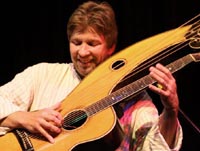
|
Volume 2, Issue 2, January, 2005
|
|
|
FOR
BEGINNERS by Stacy Hobbs |
||
|
Let me begin by saying my philosophy of playing the harp guitar may be
quite different than yours! In
fact, everyone I’ve seen play the harp guitar has their own distinct
style! I will offer tips and
pointers that have worked for me; you can utilize them for your own
purposes as you see fit. When I first began playing the harp guitar I was drawn to its huge
sound when the bass notes are pinched or alternated with the top end of a
chord played on the guitar. I’d
like to share with you some ideas on this. For this workshop you will need a basic knowledge of open position
chords and their primary and alternate bass notes (root/fifth). First thing we’re going to do is play a simple primary and
alternate bass note pattern with the right hand while holding down a G
major chord with your left hand.
For a starting place we will assign the right hand thumb to the 6th
through 4th strings on the regular guitar neck.
The index will take care of the 3rd string, middle on
the 2nd, and ring for the 1st string. Fret a G chord and play the 6th string with your right
hand thumb for beat number one, then pinch up on the first three strings
with your right hand index, middle, and ring, for the “and.”
Then play the 4th string with your right hand thumb for
beat number two, pinch up again on the same three strings for another
“and.” Repeat this entire
pattern one more time to complete a measure of 4 beats.
It reads something like "1 and 2 and 3 and 4 and."
Your thumb will only be playing on beats 1,2,3,4, alternating
between primary and alternate (root and fifth). |
This is basic guitar stuff most everyone knows.
You should work toward being able to play the primary and alternate
bass notes with all your open position chords. Let's introduce a twist to the routine, which allows us to develop
independence in the right hand thumb. Again, fretting a G chord, play the 6th string of the
guitar with your right hand index and pluck up on the first 3
strings with your right hand middle, ring, and pinky.
Awkward, huh? Now play
the 4th string with your right hand index and pinch up on the
first 3 strings again using the same 3 fingers as before.
Repeat this pattern again and again.
Apply this technique of playing the primary and alternate bass notes
with your right hand index finger to all your chords. For an exercise, try playing a simple 1-4-5 chord progression using the primary and alternate bass notes in your five major keys (C, A, G, E, D). Example: G
C D
G We have now stretched the boundaries of our right hand. While it may not have sounded very musical, it was nevertheless a useful vehicle for “freeing up” our right hand thumb. We’re now going to play the same primary and alternate bass note pattern using the “sub bass” strings this time. (See previous Issue for sub bass
tuning) |
Still fretting the G chord, play the 7th sub
bass string with your right hand thumb.
Pinch up on the first 3 strings of the guitar with your
“normal” index, middle, and ring.
Next play the 8th string followed by the pinch.
As before, use the bass notes on the 1-2-3-4 count and the pinch on
the “ands” in-between the beats. Do this until it is somewhat comfortable then try out all your
chords. Here are the primary and alternate string choices for your sub
basses: C chord uses 9th and 7th or 12th While some of these combinations may not sound “right,” the
intention is to re-train your right hand thumb. As an exercise, try playing a simple 1-4-5 chord progression using
the primary and alternate bass notes of the
sub basses. Play using
these five major keys: C, A, G, E, D. Play on!! Stacy |
|
Stacy Hobbs has been performing, recording, and teaching music for the past 22 years. He purchased his first Harp Guitar in 1998, which proved to be his true calling. Visit www.stacyhobbs.net for more! |
||
|
If you enjoyed this page, or found it useful for research, please consider supporting Harpguitars.net so that this information will be available for others like you and to future generations. Thanks!
|
|
All Site Contents Copyright © Gregg Miner, 2004,2005,2006,2007,2008. All Rights Reserved. Copyright and Fair Use of material and use of images: See Copyright and Fair Use policy. |
|
If you enjoyed this article, or found it
useful for research, please consider making a donation to The
Harp Guitar Foundation, |
|
|
|
All Site Contents Copyright © Gregg Miner,2004-2020. All Rights Reserved. Copyright and Fair Use of material and use of images: See Copyright and Fair Use policy. |